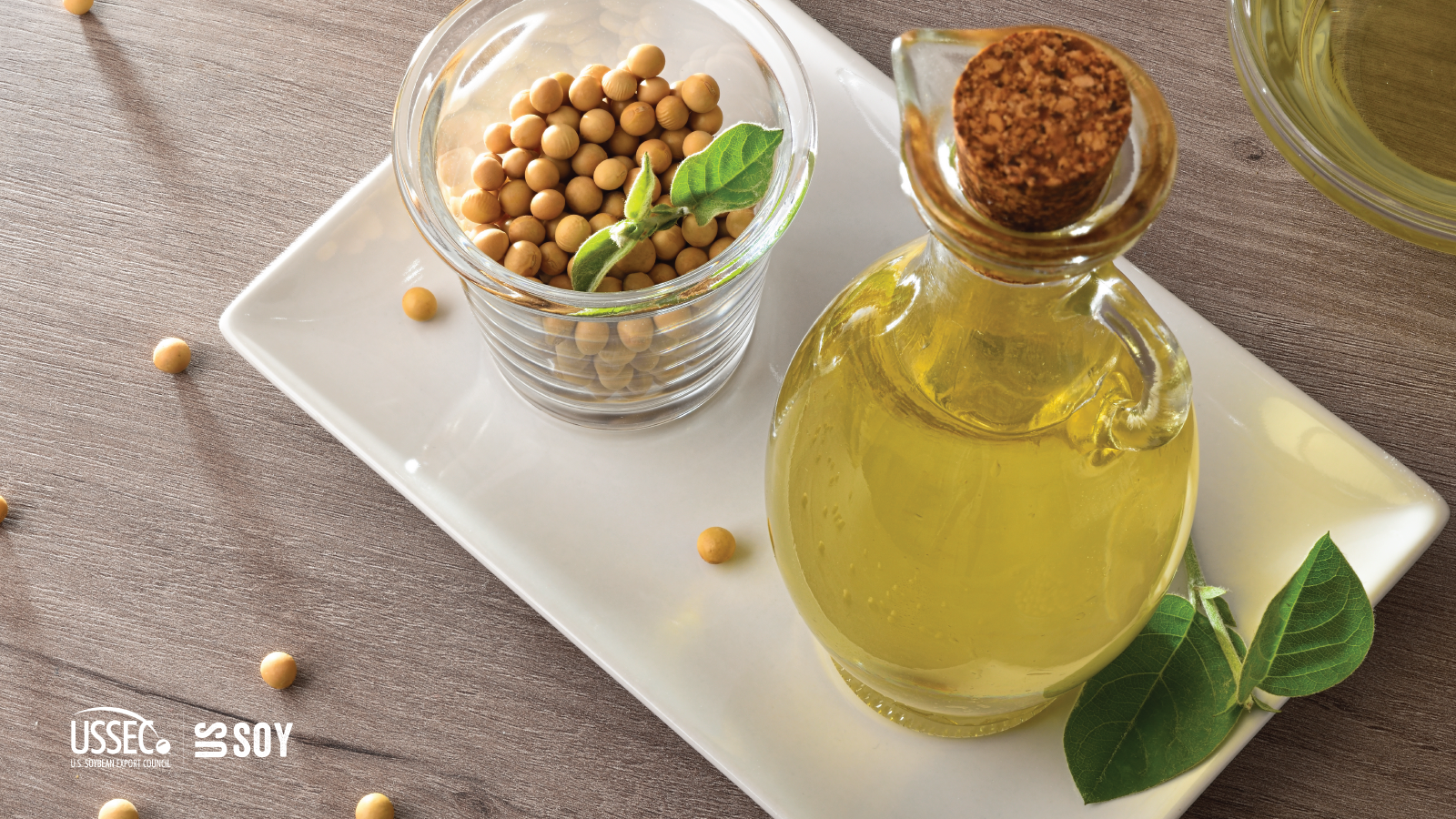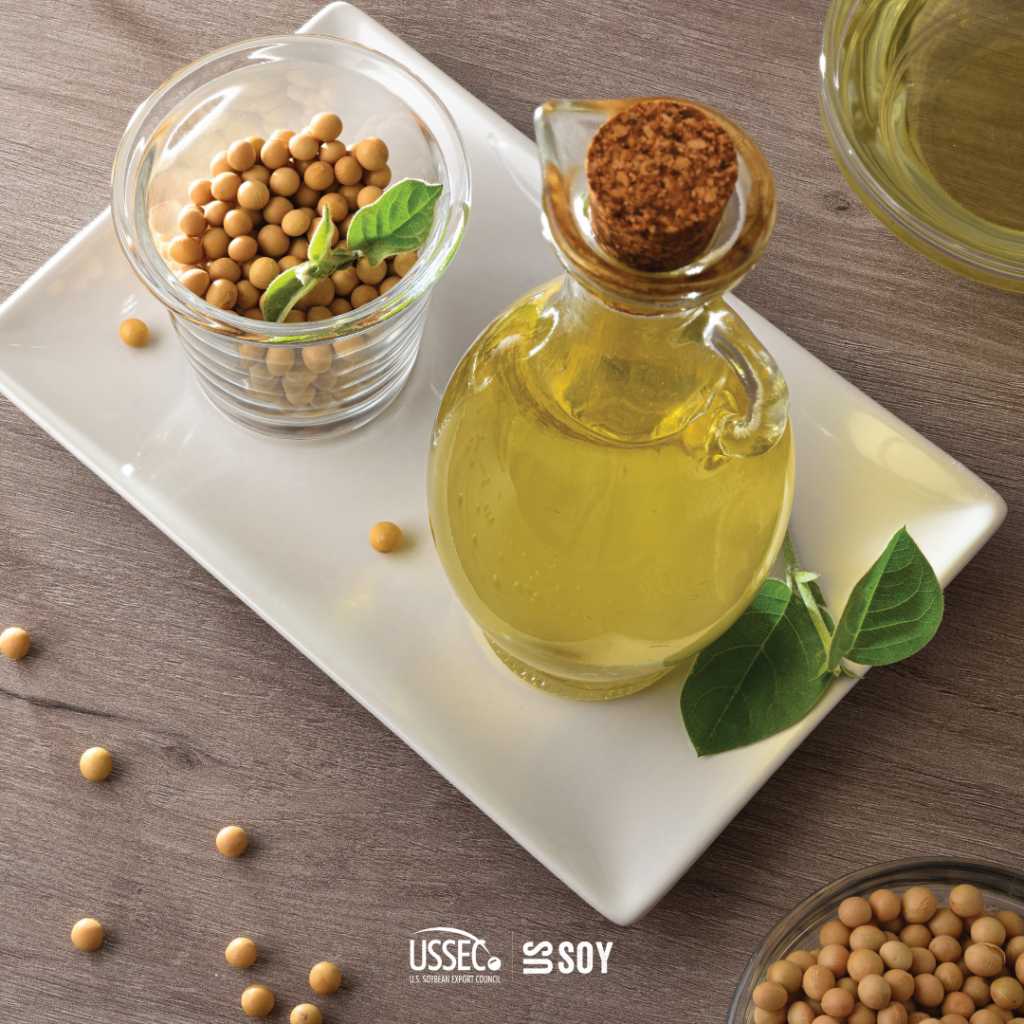
Sustainably grown U.S. soybeans are valued for both protein and oil products, and responsible and innovative farming is the key to their success. Soybeans, made up of almost 20% oil,1 are grown efficiently. They require relatively low water and energy inputs compared to other oil-producing crops.
Soybean oil—often labeled as “vegetable oil”—can easily be found in most grocery stores. It’s one of the most widely used oils in the U.S. and the world, 57% and 30%, respectively.2 What makes this oil so popular?
Fatty Acid Profile
Soybean oil features a favorable fatty acid profile. It is comprised of 62% polyunsaturated fatty acids (PUFAs), 22% monosaturated fatty acids (MUFAs), and 16% saturated fat.3 In fact, the American Heart Association recommends that most fats consumed should be PUFAs or MUFAs. The U.S. Food and Drug Administration (FDA) has recognized soybean oil’s fatty acid profile with a qualified health claim. It states: “Supportive but not conclusive scientific evidence suggests that eating about 1½ tablespoons (20.5 grams) daily of soybean oil, which contains unsaturated fat, may reduce the risk of coronary heart disease. To achieve this possible benefit, soybean oil is to replace saturated fat and not increase the total number of calories you eat in a day.”
Soybean oil accounts for over 40% of the intake of both essential fatty acids: the omega-6 fatty acid, linoleic acid, and the omega-3 fatty acid, alpha-linolenic acid (ALA).3 Omega-3s and omega-6s are essential fatty acids meaning they must be obtained through the diet because the body cannot produce it on its own but it is required for our bodies to function. Benefits of PUFAs may include improved blood pressure, heart rate, blood vessel function, and an overall reduced risk of heart disease. ALA—an omega-3 PUFA found in plant-based sources—may offer protection against cardiovascular disease and type 2 diabetes.4,5
Evidence suggests that omega-6 PUFAs reduced inflammation markers or left them unchanged. In fact, a diet high in omega-6 fatty acids as well as low in saturated fat and cholesterol can help lower cholesterol and blood sugar, reducing the risk of heart disease.3

Functional Use
Soybean oil’s neutral flavor and high smoke point make it an exceptional choice for a variety of cooking applications, such as frying, sauteing, baking, and more. It is often used in salad dressings, sauces, and marinades. Due to its neutral flavor profile, soybean oil is also favored by food manufacturers and is a common ingredient found in packaged foods, such as margarine, mayonnaise, and non-dairy creamers.
Sustainability
Sustainability increasingly impacts food purchasing decisions,6 and U.S. grown soybean oil delivers the lowest carbon footprint compared to other sources of edible oil such as rapeseed, palm and sunflower oils. In the last 40 years, U.S. soybean farmers have improved land use efficiency by 48% per bushel. They have also increased energy use efficiency (46% per bushel) while decreasing greenhouse gas emissions (43% per bushel) and soil erosion (34% per acre). All this has been accomplished while increasing production by 130%. 7
Whether you’re looking for an oil that offers a sustainable solution or one that supports heart health, soybean oil fits the bill. And if you can’t find “soybean oil” on the shelf, check the ingredient label because most vegetable oils are 100% soybean oil.
###
This article is funded in part by the soy checkoff.
References:
- https://www.nopa.org/resources/datafacts/soybean-composition/ ↩︎
- https://sniglobal.org/soybean-oil-can-positively-contribute-to-a-healthful-diet/ ↩︎
- https://sniglobal.org/wp-content/uploads/2023/10/102023_HealthProGuide_Booklet_Final.pdf ↩︎
- https://nutritionsource.hsph.harvard.edu/what-should-you-eat/fats-and-cholesterol/types-of-fat/omega-3-fats/ ↩︎
- https://www.ncbi.nlm.nih.gov/pmc/articles/PMC8308533/ ↩︎
- https://foodinsight.org/wp-content/uploads/2024/06/2024-IFIC-Food-Health-Survey.pdf ↩︎
- https://solutions.ussec.org/wp-content/uploads/2022/11/750_USSEC_SBO_U.S.-Soybean-Oil-Compared-to-Other-Vegetable-Oils_1010_NoBleedCropMarks.pdf ↩︎
